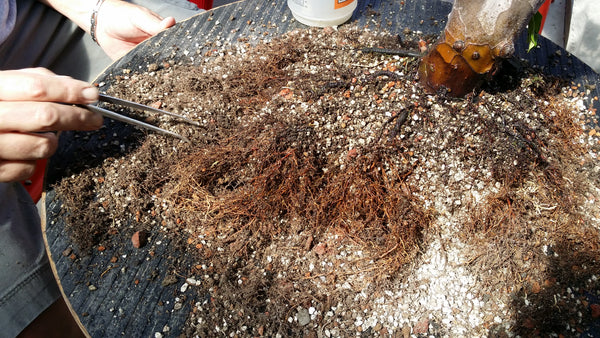Blog # 18 Chinese Quince a Year Later
Our goal is to always have fun while doing Bonsai, hence our company slogan You know you are a bonsai freak when you ...
If you look back at blog # 4 you will see some initial work done on this Chinese Quince back in July of 2013.
Please stop by my Facebook group https://www.facebook.com/groups/bonsaifreak/
In September of 2013 i removed it from its 25 gallon growing pot and spent 2 hours removing old soil and roots...it was a job.

I transferred it into a bonsai pot...this is the pot it was in for a year. Lets fast forward to last weekend class # 16, September 7th, 2014 of my Foundation program. We were covering autumn re-potting and the three main types of Quince. Since this Quince had been in my bonsai mix I wanted to see how it had grown in a year. To be honest some Quince grow a little slower and only need to be re-potted every other year. Living in California, our weather here along with placing your bonsai in a well draining mix is like a shot of steroids as the roots grow crazy for these plants. Re-potting most deciduous trees every year here is almost a must.


The great thing about pictures and dates is that it keeps us on track for what needs to be done on our plants. Here the class is using a sickle to remove the three sides of bonsai mix and roots. Our goal is one, to remove more original dirt from this plant. Last year since i had cut on this tree twice. I did not wash the old soil out as much and in Autumn during re-potting we normally do not remove as much old soil as you do in spring. Two, our goal is to start seeing our feeder roots coming from closer to the base of your bonsai and to reduce large ropy roots to promote more fibrous roots.


The new fibrous roots had completely filled the pot all the way to the edges, a good solid 5 inches of roots in one year.


Time to reduce the roots mass to focus more on widening the base. This tree has some neat history, it was planted as a seed by Gody Apon a long time member of Santa Cruz Bonsai Kai club, " rest his soul", many years ago. It then grew in the ground for I don't know how long. I purchase it in February of 2013 from well known Bonsai enthusiast Gareth Shepherd who has devoted his spare time to bonsai for about 30 years. I forget how long he had it? Sometime in its past it had been a three trunk tree as seen in this picture. This year i took it to a BIB work shop that just so happened to have Matt Reel attending after coming back from 7 years of studying in japan. He suggested I air layer or ground layer it as it has reverse taper. We then cut off one side to shorten it to give it a more aesthetic feel, then Matt said...Let it grow.


Raking out the roots...


Here we are cleaning off the work table, spraying the roots so they do not dry out and then beginning the next phase of re-potting...cutting the roots.


After removing about two inches of roots we began running into thick roots that had to be reduced...Here the students are taking turns reducing the root ball and flattening the bottom. It was at this point where one of the students said...its amazing how fascinating and intrigued we were focusing on staring and working on some roots...Funny but true. We used the root cutter to remove the biggest pieces.


Here we are combing out the top of the roots, straightening roots and still removing old soil. We used bent tweezers for this process.


Here we cut the side and the top of the roots and then we washed out a lot of old soils....next re-potting we will completely bare root and make sure there is no old soil remaining.


We prepared our pot, put down a layer of RAB drainage and then a mound of RAB premium mix in the middle, we seated the plant tied it in and added more RAB mix and worked it in to the roots.


We added sphagnum moss and then soaked the plant until the water ran clear. The last picture gives me hope; There was a little surprising we found after removing a large root, a Nebari. If I can change the Nebari by widening it and reversing the taper I may not have to air or ground layer this tree. We will check back in on this tree in a few years.
Quince tid bits
1. All parts of the Quince almost can be used to make more bonsai
2. When getting a tree from the nursery, cut the roots in half and plant the bottom half you will make a forest
3. September and October are good months for cuttings
4. Good time to re-pot is early fall
5. The fruit of the quince ripens in November, dry them out and share them to be potted in spring.
*Note RAB= RONANDERSONBONSAI MIX
Thanks for following
Ron
